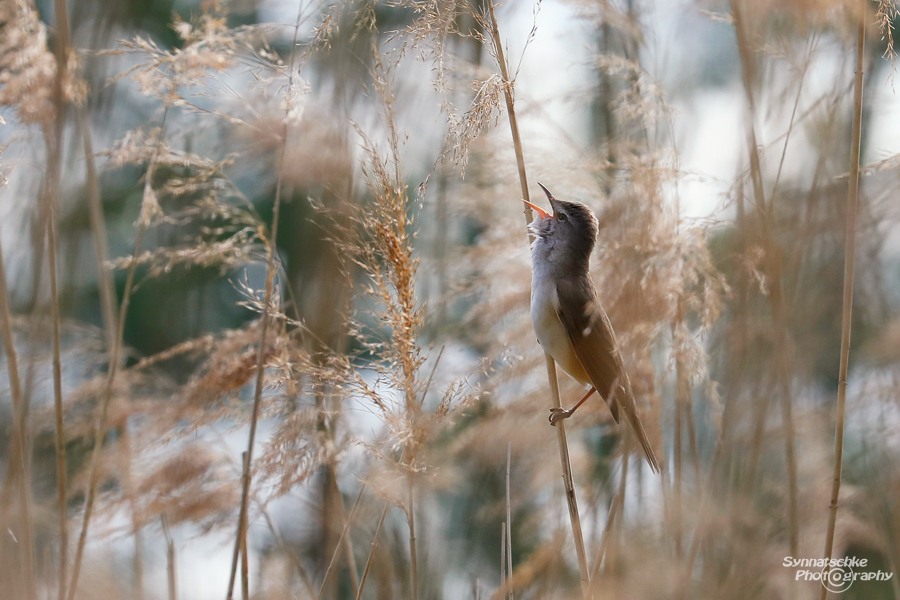
Great Reed Warbler celebrating spring
Life has pretty much slowed down during the last couple of weeks/months. Instead of traveling around the world all of us have been stuck at home. Covid-19 lockdown regulations were particularly strict here in Dresden, especially when compared to the rest of Germany. In March all walks or "movements" were restricted to a radius of only 5 kilometers (3 mi) around our home for about two weeks. After that we were allowed to travel up to 15 km (9 mi), still leaving out of reach most of our favorite places to spend our spare time. So we just drove a little bit north of town and left the car on the last parking lot within the 15 km limit and we ventured into the wooded areas nearby - a place we had never visited before.
That's where we spent most evenings during Covid-19 times, far away from other people and surrounded solely by innumerous birds, butterflies, reptiles and plants. Being forced to stay in one place for a long time, focused our senses and - for the very first time - we closely observed the awakening of nature in early spring. Not just the rising of bird songs from the trees, it also amazed us how the various types of leaves sprouted out differently from their buds. And the forest looked so beautiful when the low sun lightened up those tiny, lush green dots! And right there in the middle of all these changes the male sand lizards were turning bright green and preparing for their own "spring fever". These little creatures are way more widespread than we thought! We also began identifying the early flowering plants and their pollinators (e.g. orange tips). And in early May we were astonished by how far you can detect all those blooming rowan trees and hawthorns - they add a pungent scent of carcass and urine to the otherwise normally pleasant smells of nature.
But what fascinated us most was the two osprey nests not far away from our home. We didn't even know they had actually become common here in Eastern Germany during recent years. We saw both couples building their nests and having dinner several times. And they shared their habitat with quite a few European kestrels and common buzzards, Eurasian cranes, white storks, some marsh harriers and another extremely beautiful and large bird of prey, the red kite (Milvus milvus), which has a wingspan of up to 179 cm (70 inches). All of them were in search of food near the ponds, at the meadows or in recently mown fields. Kestrels with prey were a rather common sight, and once we witnessed a red kite catching a smaller bird and being attacked by a couple of common buzzards. There was always so much going on to entertain and distract us! During our "shelter in place" we really felt fabulously "sheltered by nature".
After the strict lockdown was lifted by mid April we started exploring the areas more to the east. That's when we fell in love with the Oberlausitz (Upper Lusatia Heath and Pond Landscape Biosphere Reserve), about a 50-minute-drive from Dresden. Designated by the UNESCO in 1996, it consists of meadows, pine forest, heather, swamps, reed beds and expanses of water, protecting the largest contiguous pond area in Germany (301 km²) and its inhabitants. The reserve is home to about 1200 endangered plant and animal species, among them 150 breeding bird species and many mammals such as the European otter, muskbeavers, and even wolves.
The Guttauer Ponds is our favorite area within the Biosphere Reserve. You can start exploring the trails, boardwalks, observation huts and towers at the headquarters, the "House of Thousand Ponds" in Wartha, or from its southern end at the small village of Guttau. Up to now we saw all the animals mentioned above (besides the wolves) and also large numbers of Eurasian cranes, three majestic white-tailed eagles and a tiny little kingfisher. Each time we were there we enjoyed the low-frequency calls of the bitterns echoing across the swamps. An amazing sound during the evening hours, especially when joined by the "spring symphony" of numerous frogs and toads.
This month's image was taken in the swamps at the Upper Lusatia Heath and Pond Landscape Biosphere Reserve and it shows a great reed warbler (Acrocephalus arundinaceus). Despite its name, this rather small (!) bird lives and breeds among the reeds during the spring and summer months. And just like all the other warblers it sings amazingly (video). We are already looking forward to what summer and fall brings to these places. We will surely continue to visit the Upper Lusatia Heath and Pond Landscape Biosphere Reserve. Nevertheless we really hope things will get back to normal soon. Stay healthy and safe everyone!
Image data: 1/800 s at f/10, ISO 1000; Canon EF 100-400 mm f/4.5-5.6 IS II USM at 400 mm, Canon EOS 5D Mark IV
